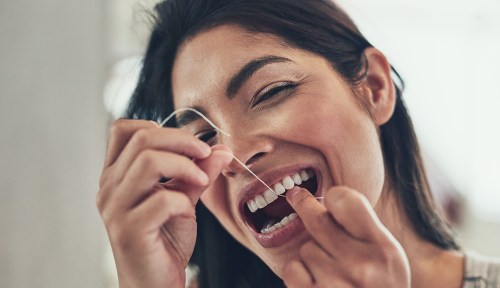Our editors independently select these products. Making a purchase through our links may earn Well+Good a commission
The Best Oral Health Tips From Dentists You’ll Want to Adopt in 2022
Oral health’s taken a hit during the pandemic due to insurance loss and fear of virus exposure, but these oral health tips can help at home.

Like many aspects of life, the pandemic’s taken a toll on our oral health. Since its start, there’s been an uptick in stress-related conditions (think: teeth grinding and jaw pain) being reported by dentists, according to a survey conducted by the American Dental Association. “Surprisingly, I’ve noticed many more cracked teeth during the pandemic. The reason for an increase in cracked teeth is people are more stressed which can lead to grinding teeth more than usual,” Adrienne Hedrick, DDS, owner of Longmont Dental Loft in Colorado, previously told Well+Good. (FYI, she’s sharing some valuable oral health tips below.)
Experts in This Article
cosmetic dentist at Lowenberg, Lituchy &
What’s more, an estimated six million Americans lost their dental insurance due to job loss reports the CareQuest Institute for Oral Health. And they also found that 11 percent of American adults (28 million) delayed going to the dentist this past year because of concerns including virus exposure risk and cost of treatments.
It’s a lot, and while anything less than a multi-pronged approach to fixing America’s health-care system feels like lip service, one place to start making meaningful changes to your own dental hygiene routine is by adopting some of the best oral health tips we learned from dentists this year—all of which are below.
1. Floss a minimum of once per day
“When food and bacteria gather between the teeth, it causes both decay and the formation of cavities, as well as the development of gingival bleeding, bad breath, gingival inflammation,” Vanessa Creaven, DMD and co-founder of Spotlight Oral Care, previously told Well+Good. “If not treated, this can ultimately lead to periodontal disease with tooth mobility and tooth loss.” Hence why learning to floss properly is so important. “You should always run the floss along the tooth structure in the shape of a C rather than just snapping quickly between each tooth,” says Brian Kantor, a cosmetic dentist at Lowenberg, Lituchy & Kantor.
Whether you should floss before or after brushing is still up for debate amongst dentists, but one thing they do seem to agree on is that consistency is what counts. And if you’re not a huge fan of dental floss, consider investing in its cooler cousin, the water flossers. “Water flossing is easy because all you have to do is hold the device and it does the water blasting for you,” says Dr. Kantor. “A Waterpik should be used at least once a day but, if you have spaces between your teeth that are always catching food and you can’t easily floss your teeth, then I suggest using a Waterpik after every meal,” he says.
2. Start scraping your tongue
“Your tongue should be taken care of just like showering your body or shampooing your hair,” New York City-based dentist Alex Rubinov, DDS, previously told Well+Good. For best results: “I recommend scraping your tongue while you still have toothpaste on it to give you the antimicrobial effect, and to leave you with the freshest breath possible,” he added. And we like this $8 one because it’s affordable and effective.
3. See your dentist every 3 to 6 months (if possible)
As we reported back in February, the American Association of Endodontists (AAE) found that more than half of Americans put off their yearly dental checkups due to COVID-19 concerns in 2020. But now that vaccines are available, if you have insurance or can cover the cost of an annual visit out of pocket, dentists strongly recommend you do so, stat. “You should go to the dentist every three to six months,” Dr. Hedrick told us. “This time frame matters a great deal as the teeth cleanings will remove calculus (hardened dental plaque) and bacteria in the mouth. If left untreated, this bacteria can not only cause issues in your mouth, but bacteria can also flow in your bloodstream to other parts of your body.”
3. Stick with soft-bristle toothbrushes
Being an aggressive brusher can hurt your teeth and gums, so choosing softer bristle and working on being more gentle when brushing your teeth will help prevent gum recession, scratches on the enamel, and gingivitis (gum inflammation). “People make a common mistake thinking if they get a medium or hard toothbrush, it will do a better job,” Inna Chern, DDS, dentist at New York General Dentistry, previously told Well+Good. “It’s recommended by the American Dental Association (ADA) to use a soft or very soft toothbrush head and change the brush every three to four months so that the bristles don’t wear and tear.”
4. Stop scrubbing with your electric toothbrush
The dentists we spoke with this year said electric toothbrushes were preferable to manual ones because they allow you to get a more in-depth cleaning experience—but that’s only the case if you’re using it properly (which most people are not as we learned from this viral TikTok video). “Brushing with an electric toothbrush is easy since the toothbrush will do the work for you,” Cincinnati-based dentist Stephanie Gans, DDS, previously told Well+Good. “Once the brush is on, move tooth-by-tooth, pausing for a few seconds at a time on each surface of your tooth.” Your pearly whites will thank you for not pressing too hard.
Oh hi! You look like someone who loves free workouts, discounts for cutting-edge wellness brands, and exclusive Well+Good content. Sign up for Well+, our online community of wellness insiders, and unlock your rewards instantly.
Sign Up for Our Daily Newsletter
Get all the latest in wellness, trends, food, fitness, beauty, and more delivered right to your inbox.
Got it, you've been added to our email list.










